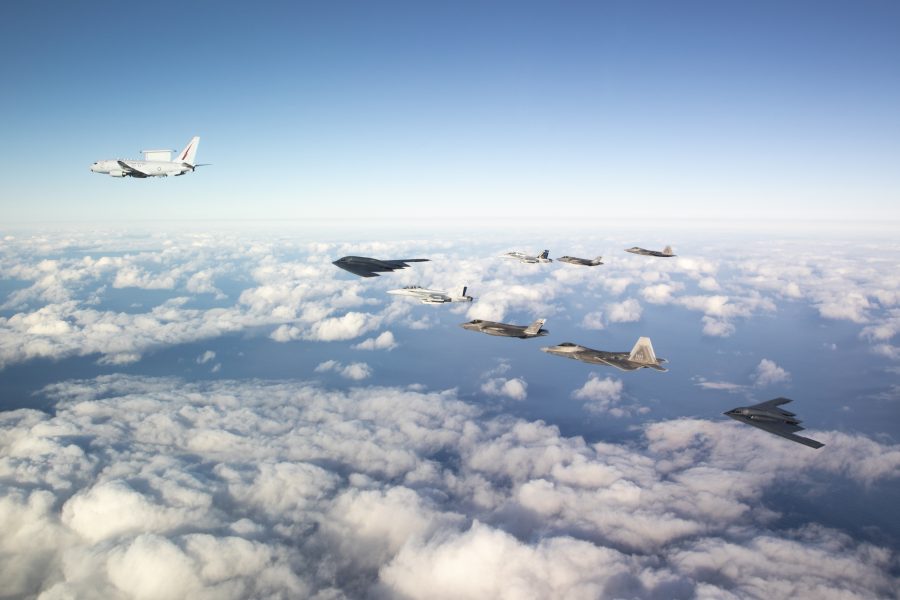The demand for Air Force bombers to conduct joint exercises, show-of-force operations, or actual combat missions has reached record-high levels—prompting the four-star in charge of their operations to consider resurrecting more bombers from the boneyard to sustain that effort.
“In the last 18 months, I have seen more activity and more demand signals for bombers than I have seen probably in the last, at least, five to 10 years,” Air Force Global Strike Command boss Gen. Thomas Bussiere said in an exclusive interview with Air & Space Forces Magazine. Bussiere is nominated to become the Air Force’s next vice chief of staff.
The service has dispatched its bomber task forces 48 times in the past year and a half, Bussiere said, including 16 deployments. The Air Force began sending its roughly 140 bombers out in small groups rather than basing them overseas for longer stretches to protect them from attack.
Another 12 bomber taskings involved flying outside the United States, taking part in training, and returning to the U.S. without stops in between, he said. Nearly half were so-called “cross-combatant command events,” he added. In those instances, bombers zig-zag from one continent to another—and possibly to a third—before returning stateside.
Some task force outings took airmen through regions such as North America, the Middle East and South America on a single deployment, Bussiere said.
“If that wasn’t enough, in the last 18 months, we had eight no-notice activations of our bomber forces; all three platforms—B-1, B-2 and B-52,” he said. Six of those entailed combat taskings “to go out and do destruction on behalf of their nation,” he added.
That includes the covert June 21 mission, dubbed Operation Midnight Hammer, to destroy facilities connected to Iran’s nuclear program. The Air Force flew seven B-2s from Whiteman Air Force Base, Mo., to Iran for the airstrikes, while another group of B-2s headed west to the Pacific as a decoy operation. Bussiere declined to say how many stealth bombers were involved in the decoy.
At least six B-2s were also deployed to Diego Garcia for more than six weeks at the request of U.S. Central Command. These aircraft conducted strikes against Houthi targets in Yemen and were on call during hostilities with Iran in the run-up to Midnight Hammer.
The remaining two bomber task forces took part in either a show of force or integration with a training exercise overseas, to “basically show the flag” and conduct national messaging, Bussiere said.
Combatant commanders are asking for BTFs because bringing a bomber to overseas drills “sends a very distinct and unique message” to allies, partners and adversaries, he said. Even a large group of smaller aircraft “doesn’t have that same messaging” because of the optics of bombers, especially those that can drop both nuclear and conventional weapons.
Bombers send “a slightly different message,” he said. “Our allies and partners love to train and integrate with our bomber force and their regional combatant commands love to have us participate in their training exercises.”
That’s led to a level of bomber activity not seen since the “throes of Iraqi Freedom and Afghanistan” in the early 2000s, Bussiere said. The demand for bombers, he said, is “unyielding.”
To maintain that tempo of deployments, Bussiere said he’s willing to pull more B-1B Lancers, a conventional bomber, out of the service’s plane graveyard at Davis-Monthan Air Force Base, Ariz.
The B-1B force shrank to 45 several years ago as the Air Force retired more than a dozen of the oldest, most worn jets in service. Global Strike has since brought back two of the airframes to replace two that were condemned after accidents: One was regenerated in place of a B-1 destroyed in an April 2022 fire, and another replaced a B-1 that crashed in January 2024.
“There’s still a few left in the boneyard that we could potentially pull out if needed,” Bussiere said.
Regenerating retired bombers isn’t a given, though. The service first considers the viability, utility, and cost of bringing a retired or damaged aircraft back to life.
In any case, Bussiere hopes the command won’t need to explore that option again: “Usually, it’s for a mishap.”


